Haiti Journal: Part IV
March 15With each new day what hope is there among the Haitian people that they might experience, in their lifetime, real change? When progress seems a distant prospect, each day requires a level of grit and determination, of patience and faith, that would be difficult for many living in the developed world to fathom, much less sustain.I think of this reality in contrast to the morning that greets those just a two-hour flight away in Miami, or even on the other side of this island in the Dominican Republic, a nation far more developed and stable than Haiti. I think of the masses in these places waking up with electricity, air-condition, modern plumbing, tap water that is drinkable. Access to basic amenities cannot be fully appreciated until one spends time without them. When you do go without, it does not take long to see basic amenities for what they are – a miracle.These are the thoughts that shift about in my mind as I lie awake in the darkness. Beyond the screen, on the mountainside, I hear the first stirrings of life – people talking, a woman singing, a dog barking. As light begins to spread over the sky, I doze off, only to be roused into a semi-conscious state by the sound of rain landing atop the tin roof. After a light shower, the sky opens and the rain falls hard upon Montrouis. The deluge suppresses the heat. There is actually a coolness in the air. This is a gift and makes for an easier start to the day.Everyone is up and dressed and moving about our quarters, waiting for a break in the rain before venturing outside. When the rain lightens up we walk down the hill to the cafeteria. Big drops or water paint our clothes with dark circles. Two stray dogs tussle and jump around in the puddles. Flowers droop. Trees glisten. No one is outside. All is quiet.Inside the cafeteria, water drips from the roof in various locations. I count five buckets collecting water, about half the number needed. All of the buckets are close to or completely full of water. The other leaks simply pool on the floor. A few Canaan staff members eat at a far table beyond reach of the leaks. The rest of the cafeteria is empty.We sit at the corner table nearest the door. A plastic pot of hibiscus tea had been put out and I pour myself a cup, add sugar, sit down. Steam rises from the top of the white mug. I put it to my lips but it is too hot to sip. The rain picks up again. Another downpour. Water falls from the ceiling as if from an open faucet. It is peaceful, therapeutic, listening to the pattering of rain atop a tin roof. In a heavy rainstorm it can be so loud it drowns out just about all else. The noise forces you to pause, to sit without speaking, to appreciate the momentary lack of activity.
A Tour of the Canaan School
After enjoying a leisurely breakfast of peanut butter and marmalade on white bread and a second cup of tea, the rain lets up and Principal Naomi takes us on a tour of the Canaan School. The rooms are warm and muggy after the rain. Under the gray sky, the classrooms are quite dark. Small wooden, cubicle desks are lined up against the wall. Student artwork, A-B-C charts, pictures of fruits with the English name underneath, and Happy Birthday messages are tacked around the room. Holes higher up in the cinderblock walls provide ventilation.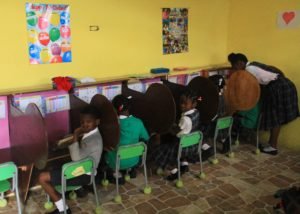 The décor and educational materials remind me of what you would see in a classroom in the States. The classrooms are tidy. Lessons are taught in English and French. The older students at Canaan know three languages – English, French, and Creole. French is the official language spoken by Government officials and employees, so it is important to speak French fluently if you wish to be considered for a government job. Creole is likely the first language of most of the children, though students are discouraged from speaking it on campus. English and French offer more opportunity, I am told.The students all stop what they are doing when we walk in and must be coaxed to continue with their work. The girls wear blue plaid jumpers, the boys navy shorts and short sleeve oxfords with red ties. The teachers are attentive to the children and go about their lessons. They also wear uniforms – a navy skirt and white blouse. One of the elementary teachers, Sister Hannah, is from Eastern Canada. She is 18-years old and will start college next year. The other teacher, Sister Liz, is a young woman from the state of Washington. Today is her 21st birthday. At Canaan, when addressing an elder, the terms “Sister” and “Brother” are placed before a person’s name as a show of respect.
The décor and educational materials remind me of what you would see in a classroom in the States. The classrooms are tidy. Lessons are taught in English and French. The older students at Canaan know three languages – English, French, and Creole. French is the official language spoken by Government officials and employees, so it is important to speak French fluently if you wish to be considered for a government job. Creole is likely the first language of most of the children, though students are discouraged from speaking it on campus. English and French offer more opportunity, I am told.The students all stop what they are doing when we walk in and must be coaxed to continue with their work. The girls wear blue plaid jumpers, the boys navy shorts and short sleeve oxfords with red ties. The teachers are attentive to the children and go about their lessons. They also wear uniforms – a navy skirt and white blouse. One of the elementary teachers, Sister Hannah, is from Eastern Canada. She is 18-years old and will start college next year. The other teacher, Sister Liz, is a young woman from the state of Washington. Today is her 21st birthday. At Canaan, when addressing an elder, the terms “Sister” and “Brother” are placed before a person’s name as a show of respect.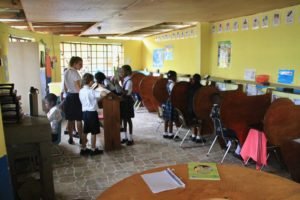 It is obvious we are a distraction and I only make myself more of one by taking photographs. The kids smile when I point my camera at them, so I put it away until the kids take to the playground. They play tag and we each take turns pushing the them on the swings. Jackson gives one of the small girls the ultimate “underdog” push, were you run underneath the swinger and push them as high as your arms will extend. The chains slack on her way up and snap back when she falls. Her smile is a perfect snapshot of that momentary euphoria children so easily access.After recess we tour the upper school, just across the road, where middle and high school students attend classes. The rooms are larger, clean, organized. There is a small library, locked with a padlock. The windows are hazy with mildew and age. I put my face up close and peer in at the well-stocked shelves of books. Curious as to what books are popular among the students, I make a note to request access before we leave so I can browse their collection.
It is obvious we are a distraction and I only make myself more of one by taking photographs. The kids smile when I point my camera at them, so I put it away until the kids take to the playground. They play tag and we each take turns pushing the them on the swings. Jackson gives one of the small girls the ultimate “underdog” push, were you run underneath the swinger and push them as high as your arms will extend. The chains slack on her way up and snap back when she falls. Her smile is a perfect snapshot of that momentary euphoria children so easily access.After recess we tour the upper school, just across the road, where middle and high school students attend classes. The rooms are larger, clean, organized. There is a small library, locked with a padlock. The windows are hazy with mildew and age. I put my face up close and peer in at the well-stocked shelves of books. Curious as to what books are popular among the students, I make a note to request access before we leave so I can browse their collection.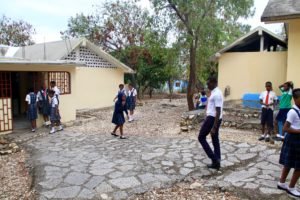 Walking back through the courtyard a girl's voice calls out, “Hi Keith!” When I turn around and say “Good morning,” I find myself staring at four girls standing shoulder to shoulder. I am still placing names with faces, so I speak to the group. “How are you all doing today?” I ask. “Good," one of them answers. Two of the girls look at each other and chuckle. I wonder if they are making fun of me. Why would they not? I'm the pale, goofy guy who walks around with a camera and can't stop sweating. If I were them, I would make fun of me. After all, there's quite a bit to make fun of. “Have a great day,” I say. “I’ll see you later.” The girls smile and say, “Bye.”The teachers at the upper school are Haitian. The math and science teacher, Brother LaPort, studied Chemistry at the University in Port-au-Prince. He also learned German and speaks fluent French. Brother LaPort looks young, mid-20s if I were to guess. One of his courses is calculus, which he teaches to the oldest high school students. He is dressed in blue slacks, a long-sleeve, white oxford buttoned at the neck, and wears a red tie.The uniforms bring an air of professionalism to the school, but the male uniforms, in particular, seem asphyxiating. I am wearing a short-sleeved t-shirt, wiping sweat as we talk, and can’t imagine how they concentrate in this heat and humidity. That said, Brother LaPort appears comfortable, going about his business without a bead of sweat on his face.We wrap up our brief conversation, shake hands and leave him to his work. I am so impressed by this tall, soft-spoken, highly educated man. Outside his classroom, Ricky and Principal Naomi discuss how fortunate they are to have Brother LaPort, as any school would be. From what I gather during our short interaction, he seems a tremendous asset to Canaan and an excellent roll model for these young children.
Walking back through the courtyard a girl's voice calls out, “Hi Keith!” When I turn around and say “Good morning,” I find myself staring at four girls standing shoulder to shoulder. I am still placing names with faces, so I speak to the group. “How are you all doing today?” I ask. “Good," one of them answers. Two of the girls look at each other and chuckle. I wonder if they are making fun of me. Why would they not? I'm the pale, goofy guy who walks around with a camera and can't stop sweating. If I were them, I would make fun of me. After all, there's quite a bit to make fun of. “Have a great day,” I say. “I’ll see you later.” The girls smile and say, “Bye.”The teachers at the upper school are Haitian. The math and science teacher, Brother LaPort, studied Chemistry at the University in Port-au-Prince. He also learned German and speaks fluent French. Brother LaPort looks young, mid-20s if I were to guess. One of his courses is calculus, which he teaches to the oldest high school students. He is dressed in blue slacks, a long-sleeve, white oxford buttoned at the neck, and wears a red tie.The uniforms bring an air of professionalism to the school, but the male uniforms, in particular, seem asphyxiating. I am wearing a short-sleeved t-shirt, wiping sweat as we talk, and can’t imagine how they concentrate in this heat and humidity. That said, Brother LaPort appears comfortable, going about his business without a bead of sweat on his face.We wrap up our brief conversation, shake hands and leave him to his work. I am so impressed by this tall, soft-spoken, highly educated man. Outside his classroom, Ricky and Principal Naomi discuss how fortunate they are to have Brother LaPort, as any school would be. From what I gather during our short interaction, he seems a tremendous asset to Canaan and an excellent roll model for these young children.
An Education In Carpentry
Before we begin work on the kitchen ceiling, we go to our quarters and carry two suitcases full of school supplies back down the hill – reams of white and lined paper, wooden pencils, pencil sharpeners, colored markers and pencil sets, crayons, ballpoint pens and notebooks. There are also soccer and volleyballs and an assortment of other sporting goods for PE. Principal Naomi was especially thrilled to have the paper. “Paper!" she said, excitedly. "We really need paper." Apparently, they had not been able to find any locally.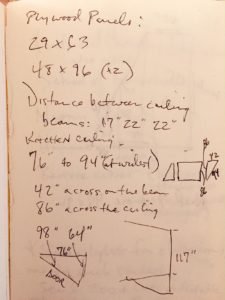 The clouds move away and the sun quickly dries the dampness left by the storm. The rest of the day is reserved for work on the kitchen ceiling. Ricky, Jackson and I measure distances, scribble them in my journal, and try to determine the corresponding angles. Ricky seems to have retained what he learned in high school geometry, whereas I did not. Jackson, Ricky’s nephew, also helps. They are the brains of the outfit. I am little more than an additional set of hands.Once they are confident with their calculations, we use a long straight edge ruler and wood planks to pencil our cuts on large sheets of plywood and 2x4s. Ricky and I take turns cutting the wood with a skill saw, the same saw, Pastor Henri tells us, that he just used to carve up a goat for Sister Liz’s 21st birthday dinner tonight. Upon hearing this, I cannot help but visualize the scene. But soon work continues, and my mind is once again occupied by concerns for my own safety. When using the skill saw, I remind myself, try not to cut off a finger, or worse, a hand. When climbing the ladder, beware the jagged, rusty nails that could easily tear open your scalp. When hammering, be careful not to crush your fingers. High on my wish list for this trip is avoiding serious injury and a trip to the clinic.Mid-afternoon, Shae and Jackson run camp for the kids inside the new cafeteria. They play paddle ball, blow up beach balls, and play other games while Ricky and I continue work on the ceiling. At one point, he and I are asked to break away from our work and act surprised when the kids run in and douse us with crazy string. The ambush goes off without a hitch and fills the room with smiles and laughter.
The clouds move away and the sun quickly dries the dampness left by the storm. The rest of the day is reserved for work on the kitchen ceiling. Ricky, Jackson and I measure distances, scribble them in my journal, and try to determine the corresponding angles. Ricky seems to have retained what he learned in high school geometry, whereas I did not. Jackson, Ricky’s nephew, also helps. They are the brains of the outfit. I am little more than an additional set of hands.Once they are confident with their calculations, we use a long straight edge ruler and wood planks to pencil our cuts on large sheets of plywood and 2x4s. Ricky and I take turns cutting the wood with a skill saw, the same saw, Pastor Henri tells us, that he just used to carve up a goat for Sister Liz’s 21st birthday dinner tonight. Upon hearing this, I cannot help but visualize the scene. But soon work continues, and my mind is once again occupied by concerns for my own safety. When using the skill saw, I remind myself, try not to cut off a finger, or worse, a hand. When climbing the ladder, beware the jagged, rusty nails that could easily tear open your scalp. When hammering, be careful not to crush your fingers. High on my wish list for this trip is avoiding serious injury and a trip to the clinic.Mid-afternoon, Shae and Jackson run camp for the kids inside the new cafeteria. They play paddle ball, blow up beach balls, and play other games while Ricky and I continue work on the ceiling. At one point, he and I are asked to break away from our work and act surprised when the kids run in and douse us with crazy string. The ambush goes off without a hitch and fills the room with smiles and laughter.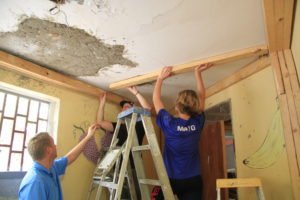 By the end of the workday I have measured and cut wood, held large sheets of it over my head while balancing on a ladder, hammered nails into solid concrete and sweat through my clothes multiple times. Working with Ricky, Jackson, and an occasional visit from Pastor Henri has made the experience a real pleasure. Toward the end of the day, when we could hardly lift our arms, we were assisted by Rafael, a local Creole speaking gentleman who handles maintenance on campus. Rafael, despite being older than us and lean in stature, can hammer a nail into cement with five our six whacks, where as it was taking Ricky, Jackson and I 30 to 40. Today’s progress was not at all bad for novice carpenters, but we still have a way to go.
By the end of the workday I have measured and cut wood, held large sheets of it over my head while balancing on a ladder, hammered nails into solid concrete and sweat through my clothes multiple times. Working with Ricky, Jackson, and an occasional visit from Pastor Henri has made the experience a real pleasure. Toward the end of the day, when we could hardly lift our arms, we were assisted by Rafael, a local Creole speaking gentleman who handles maintenance on campus. Rafael, despite being older than us and lean in stature, can hammer a nail into cement with five our six whacks, where as it was taking Ricky, Jackson and I 30 to 40. Today’s progress was not at all bad for novice carpenters, but we still have a way to go.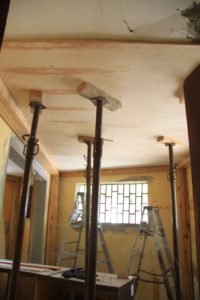 Before dinner I hike back up the hill to our quarters and walk into to the bathroom to freshen up. Looking in the mirror, I see that my face and neck are covered in red blotches. A heat rash of some sort. In addition, I have a couple dozen bugs bites on my face, neck and arms. The heat and bugs add to the challenges of life in Haiti. Coming from a cooler, dryer climate, my body is taking some time to acclimate. It is not an easy environment in which to function, but I assume like anything, you adapt. I turn on the spigot and splash cool water over my face, dab it dry with a towel and sit still on the edge of the bed in the hopes that the rash will dissipate. When I look in the mirror after a ten minute rest the blotches are far less noticeable.
Before dinner I hike back up the hill to our quarters and walk into to the bathroom to freshen up. Looking in the mirror, I see that my face and neck are covered in red blotches. A heat rash of some sort. In addition, I have a couple dozen bugs bites on my face, neck and arms. The heat and bugs add to the challenges of life in Haiti. Coming from a cooler, dryer climate, my body is taking some time to acclimate. It is not an easy environment in which to function, but I assume like anything, you adapt. I turn on the spigot and splash cool water over my face, dab it dry with a towel and sit still on the edge of the bed in the hopes that the rash will dissipate. When I look in the mirror after a ten minute rest the blotches are far less noticeable.
A Short Hike with a View
Ricky and Shae come into the room and ask if I'd like to hike to the water tank atop the hill where there is a nice view of the mountains and the ocean. I grab my camera and join them, walking slowly, almost at a stroll, to keep from overheating. Jackson joins us, as does Ricky and Shae’s youngest son, while their daughter plays with the girls her age down by the cafeteria. The sun is low on the horizon and not so hot. The duration of the hike is no more than five minutes, which suits me fine. Along the way we pass a stray donkey, alone on the hillside, pulling scarce sprigs of greenery from the rocky soil.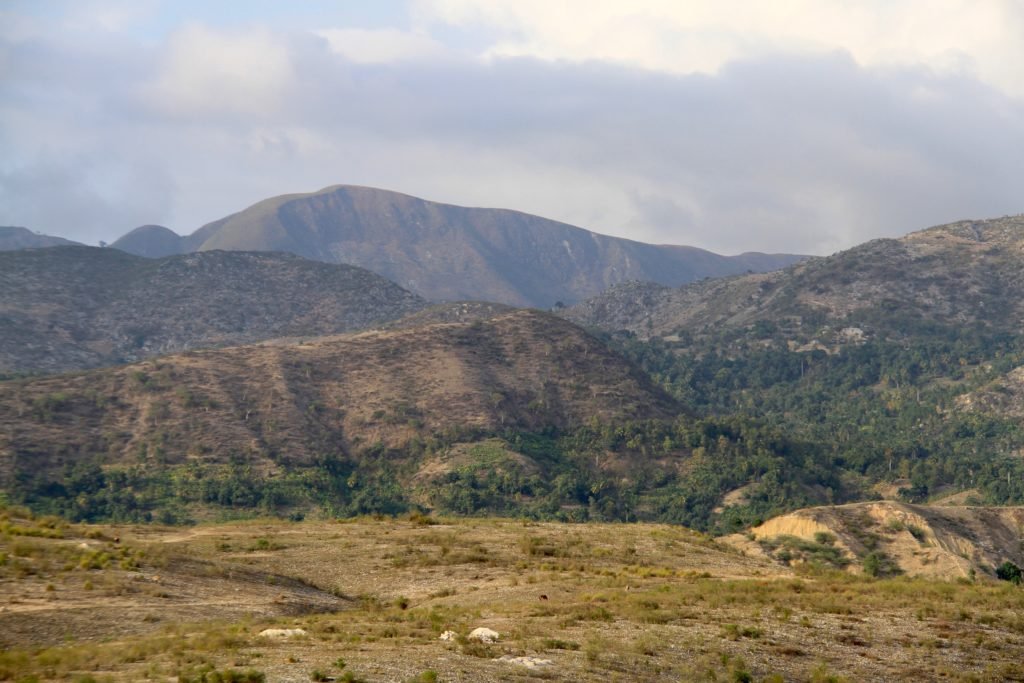 From the water tank, the view extends in all directions. To the west is the shimmering Canal de Saint-Marc. Just below us is the property of Canaan, canopied with tall trees. On either side are small hillside villages, mostly void of trees. To the east are mountains, tall and rugged and green. They remind me of summertime mountains in parts of the Southwestern U.S.Later I find a map and see that these mountains are called the Chaine des Matheux. The tallest among them is a 5,203 ft. peak that is unnamed, at least on the map. This elevation is significantly lower than Haiti’s tallest peak, Pic la Selle, which rises to 8,793 ft., but the Chaine des Matheux are impressive nonetheless. The ocean breeze from atop the dry and dormant water tank is steady and pleasant and the view is one of the prettiest I have seen in Haiti.
From the water tank, the view extends in all directions. To the west is the shimmering Canal de Saint-Marc. Just below us is the property of Canaan, canopied with tall trees. On either side are small hillside villages, mostly void of trees. To the east are mountains, tall and rugged and green. They remind me of summertime mountains in parts of the Southwestern U.S.Later I find a map and see that these mountains are called the Chaine des Matheux. The tallest among them is a 5,203 ft. peak that is unnamed, at least on the map. This elevation is significantly lower than Haiti’s tallest peak, Pic la Selle, which rises to 8,793 ft., but the Chaine des Matheux are impressive nonetheless. The ocean breeze from atop the dry and dormant water tank is steady and pleasant and the view is one of the prettiest I have seen in Haiti.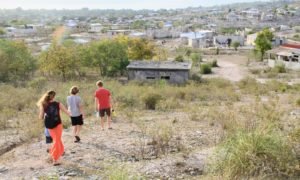 As I snap photos, the dinner bell rattles from somewhere underneath the treetops of Canaan. It’s time to eat. We hop from the tank and walk back down the path to the cafeteria.At the cafeteria we are greeted by Tadgina. "Hi Tadgina," I say. "Anything spectacular happened today?" I am surprised by her excited reply. “Yes!” she says. “Oh wow, let’s hear it!” Ricky says. With a shy, but proud smile, Tadgina says, “I got a one-hundred percent on my geography test.” We all congratulate her and slap high-fives.Pastor Henri makes his way over to us, leans into the conversation and says, “Go get yourselves some goat!”Ricky and I shoot each other a quick look and do as he says, following Pastor Henri to the serving table to fill our plates.Visit the Canaan Christian Community Website
As I snap photos, the dinner bell rattles from somewhere underneath the treetops of Canaan. It’s time to eat. We hop from the tank and walk back down the path to the cafeteria.At the cafeteria we are greeted by Tadgina. "Hi Tadgina," I say. "Anything spectacular happened today?" I am surprised by her excited reply. “Yes!” she says. “Oh wow, let’s hear it!” Ricky says. With a shy, but proud smile, Tadgina says, “I got a one-hundred percent on my geography test.” We all congratulate her and slap high-fives.Pastor Henri makes his way over to us, leans into the conversation and says, “Go get yourselves some goat!”Ricky and I shoot each other a quick look and do as he says, following Pastor Henri to the serving table to fill our plates.Visit the Canaan Christian Community Website
